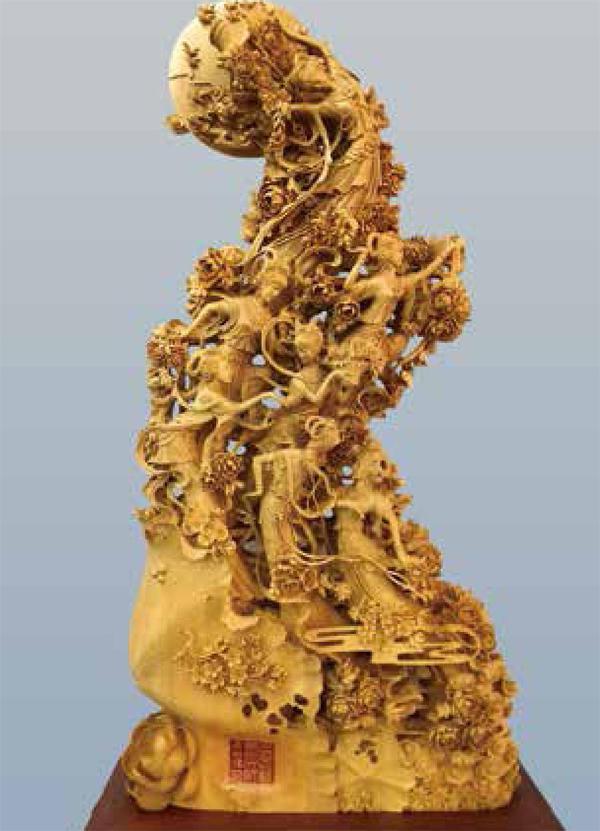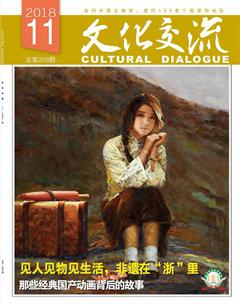浙江筹建省级非遗馆让“非遗珍珠”重放光华
胡昊

浙江大地人文荟萃,孕育了众多非物质文化的瑰宝:蚕桑丝织技艺、龙泉青瓷、浙派古琴……目前浙江共有10个人类非遗项目、217个国家级非遗项目、886个省级非遗项目,数量位居全国各省之首,它们构筑起一座璀璨夺目的文化宝库。
9月底,在第十届浙江·中国非物质文化遗产博览会上,这座文化宝库掀起盖头的一角,散发出闪耀的光芒。作为博览会的一部分,“天工巧作——浙江非遗馆捐赠作品精品展”展出的都是浙江非遗大师们的精品力作,引来不少关注。
自2017年浙江省非物质文化遗产馆启动藏品收集工作以来,目前已有48位非遗代表性传承人和工艺美术大师捐赠了69件(套)作品。这些传承着文化精髓的大师们也希望通过自己的作品,推动形成人人传承中华优秀传统文化的生动局面。
藏品征集背后,感人故事不少
第十届浙江·中国非物质文化遗产博览会的“天工巧作——浙江非遗馆捐赠作品精品展”上,22位国家级非遗项目代表性传承人和中国工艺美术大师的31件(套)大师作品亮相。这些大师名作涵盖浙江省内具有代表性的传统刺绣、纸艺彩扎、传统五金、陶瓷、镶嵌、石雕等传统工艺类项目。
在展品当中,有一件名为《农家记忆》的龙泉青瓷作品尤为引人注目。这件作品是纯手工拉胚成型,青瓷釉色相当平和,一看就给人一种温润宁静的感觉。这是第五批国家级非遗项目代表性传承人、龙泉青瓷名家张绍斌的遗作。弥留之际,这位年仅62岁的传承人叮嘱家人,一定要把这件最重要的作品捐献给浙江省非遗馆。这件作品由张绍斌的儿子、已经在龙泉青瓷的创作上颇有成就的张笃良代为捐赠。
事实上,“天工巧作”展出的这些藏品,是第二批浙江非遗大师捐赠给浙江非遗馆的珍品。
2017年11月23日,筹建中的省非物质文化遗产馆迎来了第一批重要藏品。陆光正、徐朝兴、周锦云、高公博、嵇锡贵等26位非遗代表性传承人和工艺美术大师向省非遗馆捐赠了38件(套)非遗作品。这些作品件件都属大家之作,处处体现传统工艺的匠心之美。
省级非遗代表性传承人、中国工艺美术大师赵锡祥捐出了一件萧山花边作品——特重工万缕丝真丝全雕垫绣镶边挂毯。挂毯长2.6米,高1.7米,于2016年由45名萧山绣娘花了3个月时间制作完成,在纹样设计、绣艺应用和材质选用上均较以往有新的突破。挂毯纹样以孔雀尾纹与花卉相结合,上有牡丹、玫瑰、菊花、月季等形态各异的花卉330朵,另有晶莹剔透的葡萄1088颗;绣艺上釆用抽拉丝针法和垫绣工艺;材质则选用了真丝绒。整幅作品虚实相间,呈现出浮雕般的艺术效果,被誉为萧山花边的巅峰之作。
赵锡祥捐赠的作品中,还有一块1.7米见方的5151万缕丝方台毯,它是赵錫祥的岳父、老艺人胡兆康在上世纪40年代完成的。这块方台毯的图样设计匠心独具,布局简洁大气。这个式样的花边作品后来演化为上千个款式,曾荣获国家优质产品“金质奖”和中国工艺美术百花杯“金杯奖”,深受消费者青睐。“萧山花边是省级非遗项目,这块方台毯是萧山花边的代表作。我把它捐出来,就是想让更多人了解萧山花边。”赵锡祥说。
“龙档”又称“板凳龙”,是具有浓郁乐清地方民间传统特色的工艺美术,2008年入选第二批国家级非物质文化遗产名录。“龙档的经济价值是无法衡量的。”国家级非遗项目代表性传承人黄德清说起龙档,自豪满满。他捐赠的龙档长35米,以香樟木和榆木为原料,采用圆雕、透雕、镂雕、浮雕等多种雕刻技法,并运用油漆贴金彩绘、竹编、刺绣等多种工艺。其最大的特色是龙档刻有来自《西游记》《白蛇传》等古典名著、民间传说里的700多个人物。在档头、档尾、小档背上还刻有《姜子牙点将》《拷红》《三堂会审》等故事。
说起每件作品的精致之处,几乎所有的传承人和工艺美术大师都能说个半天。在他们的心里,这些作品如同自己的孩子,左看右看都是好的。
从筹建到征集,“国宝级”大师响应
浙江省委、省政府一直高度重视非物质文化遗产保护事业。自2003年被确定为中国民族民间文化保护综合试点省以来,我省的非遗保护工作不但创造了非遗普查的“浙江模式”、连续4批国家级非遗项目数排名全国第一的“浙江现象”,而且创新性地在全国非遗保护传承中开拓了“浙江经验”。
“浙江非遗馆里面应该展示什么?”这是一直困扰省非遗保护工作者们的一个大问题。
早在2017年初,在浙江省非遗馆筹建过程中,不少人士提出是否可以邀请非遗代项目表性传承人和工艺美术大师们捐赠一部分代表性的作品:一来,非遗馆筹建在全国都属罕见,没有经验可循,只能靠这些非遗代表性传承人“救急”;二来,通过展示名家名作,也能让非遗馆真真正正成为浙江非遗宣传、展示、教育和研究的一个重要窗口。
2017年5月,省文化厅相关人士赴青田、龙泉等地开展调研,看望倪东方、徐朝兴、刘江等非遗代表性传承人和工艺美术大师,提出了这一设想。
当年7月至9月,省非遗保护中心组织非遗专家开展作品征集,他们辗转龙泉、青田、东阳、乐清、宁海、椒江等12个县(市、区),与省内36位非遗代表性传承人和工艺美术大师进行深入的沟通与交流,希望他们拿出具有代表性的非遗作品。
当年8月,10多位“国宝级”大师在省非遗馆筹备会议上,宣布将自己的部分作品捐赠给省非遗馆收藏。他们还号召全省各级非遗代表性传承人尽力提供作品或藏品。代表这些大师宣读倡议的是东阳木雕国家级非遗代表性传承人、中国工艺美术大师陆光正,他表示非遗代表性传承人有责任也有义务尽自己的一分力量,全力配合并积极支持省非遗馆的建设。他们向省非遗馆捐赠本人的代表性作品和相关实物资料,同时也向全省非遗代表性传承人积极倡议:将个人所拥有的作品(或藏品)捐赠给省非遗馆收藏,进一步发挥省非遗馆的宣传、展示、教育、研究功能。
“我们希望更多的非遗代表性传承人能够拿出具有收藏价值和能够代表非遗技艺的作品或道具,为非遗的传播、传承和发展提供支持。”省文化厅相关人士说,省非遗馆的建设不同于博物馆、图书馆和文化馆,没有现成的经验,非遗馆藏品的征集也是一个需要不断积累的过程。
館藏除了“国宝”,也有异域风情
除了浙江的“国宝”外,浙江非遗馆还兼收并蓄,收藏了部分境外非遗藏品。这些藏品来自于第二届“中国——中东欧国家非物质文化遗产保护专家级论坛”的参会国家和地区,比如波黑的参会代表米蕾拉·米莉切维奇·舍契奇女士捐赠的作品木制首饰盒、圆形托盘、钉蹄铁蛋等,塞尔维亚的参会代表达尔科·克洛帕诺维奇先生捐赠的作品扎拉库沙陶瓷等,斯洛文尼亚民族博物馆的参会代表坦亚·罗曾贝尔加尔女士捐赠的作品心型姜饼、“小面包”木模、彩绘蜂窝板等,中国澳门的国家级非遗代表性传承人曾德衡先生创作的佛像雕刻等作品。
“文化具有包容性。我们在展示自己的非遗名作的同时,应该为世界非遗提供一个展示的舞台,这不但体现了浙江非遗馆的包容性,也体现了中国非遗的包容性,是联合国教科文组织颁发的《保护非物质文化遗产公约》中对于非遗保护和传承最好的实践。”浙江省非遗保护中心相关负责人介绍说,对于保护,《公约》要求不但要确认、立档、研究、保存,更要实现保护、宣传、弘扬、传承和振兴,“世界其他国家和地区的非遗同样面临和中国的非遗一样的局面,需要全人类共同努力去营造一个保护的空间。”
另外,在“互联网+”时代,我省非遗数据库的建设一直走在全国前列,浙江省非物质文化遗产保护数据库平台迄今已采录200余万条数据。这些数据也将被浙江省非遗馆收入保存。
Museum Collects Masterpieces of Intangible Cultural Heritage
By Hu Hao
Zhejiang leads China in owning the countrys biggest treasure of intangible cultural heritage. At present, the province in eastern China not only has 217 items in ten categories inscribed on the national list of intangible cultural heritage of humanity but also has 886 intangible cultural heritage items under the safeguarding of the province.
Hangzhou, capital of Zhejiang, showcased some heritage masterpieces during Zhejiang-China Expo on Intangible Cultural Heritage from September 19 to 23, 2018. The White Horse Lake International Convention & Exhibition Center served as the venue for the five-day event.
Since Zhejiang Museum for Intangible Cultural Heritage, now still in its preparatory stage, began to build up a collection of masterpieces of intangible cultural heritage in 2017, 48 heritage inheritors and masters of arts and crafts have contributed 69 pieces/sets of artworks to the museum.
The expo at the White Horse Lake presented 31 pieces/sets of artworks that represented 22 national inheritors and masters from the museums collection. The exhibits covered a wide range of traditional arts and crafts including embroidery, paper art, pottery, stone-carving, and metal tools.
One eye-catching exhibit was “Rural Memory”, a Longquan celadon work of art created by Zhang Shaobin, a certified inheritor on the fifth national list of intangible cultural heritage. The 62-year-old master instructed his family to donate the piece to the museum before he passed away. His son Zhang Duliang, also a celadon master, donated his fathers masterpiece to the museum.
In fact, the exhibits at the White Horse Lake in September were all from the second batch of masterpieces donated by inheritors and masters. The museum received its first batch of 38 masterpieces from 26 inheritors and masters November 23, 2017.
The first batch included some rare items. A 1.7-m2 silk desk carpet, donated by Zhao Xixiang, was created by Hu Zhaokang, Zhaos father-in-law, in the 1940s. The intricate design shows masterful touches and presents a simple and majestic style. A representative masterpiece of Xiaoshan Lacework, a provincial intangible cultural heritage, the silk carpet has served as a prototype and inspired more than 1,000 variations on the original over decades. Zhao Xixiang is a national master of arts and crafts and inheritor of intangible cultural heritage at the provincial level.
Another important donation is “Bench Dragon” of Yueqing, a county-level city in southern Zhejiang. The 35-meter-long dragon, created and donated by Huang Deqing, a national inheritor of intangible cultural heritage, is a woodcarving masterpiece. It presents more than 700 figures from classical novels and folk tales. Huang thought the value of the masterpiece couldnt be overestimated.
When the heritage museum project was launched in early 2017, people engaged in this project wondered what the museum was to display to the world. After a brainstorm, someone suggested to see if some inheritors and masters were ready to donate some of their representative pieces to the museum. The suggestion was pragmatic: the unprecedented museum needed these inheritors to justify its existence and the museum could turn itself into a window on the provinces wealth of intangible cultural heritage through a meaningful presentation.
In May 2017, a group of officials from the provincial cultural authorities visited masters such as Ni Dongfang, Xu Chaoxing and Liu Jiang in Qingtian and Longquan and held a discussion on the issue with these masters. From July to September, a group of experts from the provinces center for safeguarding of intangible cultural heritage visited inheritors and masters in 12 counties and county-level cities across the province.
In August 2017, over ten national masters announced their respective donations to the museum at a meeting at the provincial level. They called inheritors at all levels across the province to donate their representative pieces to the museum.
The officials at Zhejiang Administration of Culture remarked: “We hope more inheritors can donate their works that represent the intangible cultural heritage so as to promote the publics awareness of the heritage and help safeguard the heritage for future generations.“ It is noted that there is no successful experience about how to run a museum of intangible cultural heritage. Such a museum is different from conventional museums, libraries and cultural centers. The buildup of the collection takes time.
In the collection of the museum are some contributions from central and eastern European countries. Zhejiang has built up a database of 2 million entries on intangible cultural heritage, which is now also in the collection of the museum.

